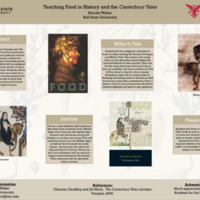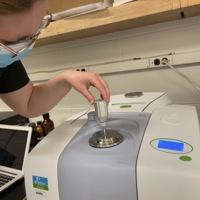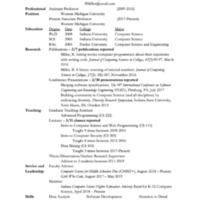Browse Exhibits (16 total)
Alijah Forbes | The Effects of Agreeableness and Political Orientation on Perceptions of Aggression in Media
Research on aggression in media is often focused on the aggression’s influence of later aggressive acts. One area that is often not researched is the perceptions of these aggressive acts, and how they are influenced. Prior research on influences on perceptions have shown that they can be influenced by ingroup bias (Hastorf & Cantril,1954; Kim, 2016) and differences in personality (Costa & McCrae, 1986). These areas of research can be tied together in order to look at the differences of perceptions of aggressive acts and how they are influenced, specifically looking at political ideology and agreeableness. This is the focus of the present study, by seeing how the differences of political ideology and agreeableness affect how individuals perceive acts of aggression. The acts of aggression that will be focused on are video media of interactions between police and protestors during a Black Lives Matter protest.
Faculty Mentor: Dr. Thomas Holtgraves
Psychological Science
Undergraduate
Honors College
Anna Himes | Trait Anxiety and Assessment of Ambiguous Emotions
The purpose of the current study is to examine whether trait anxiety affects participants’ ability to recognize facial emotions. Past research has supported the notion that high levels of anxiety may result in an inaccurate recognition of emotion. Specifically, possibly through mechanisms such as the Facial Feedback Hypothesis and Embodied Emotion Simulation, past research has supported the notion that individuals with anxiety are more likely to misclassify nonthreatening emotions as threatening. However, there has yet to be a robust set of studies that observe this relationship with the added factor of ambiguity created by surgical masks. In this study, college students completed a trait anxiety measure and emotion-recognition task consisting of 56 photographs of Black and White males and females who were expressing anger, fear, disgust, happiness, calm, sadness, or neutrality. Half of the photographs included surgical masks covering the bottom half of the person’s face. Three hypotheses were tested: Participants with higher trait anxiety will be less accurate at identifying masked and unmasked emotions than participants with lower trait anxiety overall; Participants with high trait anxiety will misclassify non-threatening masked and unmasked emotions (happy, calm, neutral) as threatening emotions (anger, disgust, fear) more often than participants with low trait-anxiety; and participants with high and with low trait anxiety will perform more accurately in assessing unmasked emotions than in assessing masked emotions.
Faculty Mentor: Dr. Kristin Ritchey
Department of Psychological Sciences
Undergraduate
Honors College
Audrey Hasser | The Relationship of Parental Communication and Emerging Adulthood Risky Behaviors of Binge Drinking and Vaping
Past research regarding parental communication and risk-taking behaviors largely focuses on risk-taking behaviors happening during adolescence, more specifically, the focus has largely been on sexual risk-taking behaviors. The current research examines this relationship of quality parental communication and risk-taking behaviors but shifts the focus to risk-taking behaviors happening in a different developmental period—emerging adulthood. The risk-taking behaviors examined in the present study are risky drinking behaviors, such as binge drinking and the risk taking behavior of vaping, as they have not been extensively researched in the past. The present study’s objective was to determine whether quality parental communication happening during adolescence would be related to risk-taking behaviors happening in emerging adulthood. Specifically, it was hypothesized that quality parent-adolescent communication would have a negative relationship with both alcohol use and the use of electronic cigarettes during emerging adulthood. Participants completed measures of parent-adolescent communication as well as measures regarding their current drinking and vaping habits and correlation and regression analysis were conducted. The results of these analysis indicated that quality parental communication during adolescence had a significant negative correlation with alcohol use in emerging adulthood but no correlation was found for quality parental communication and vaping habits.
Faculty mentor: Anjolii Diaz
Department of Psychological Science
Undergraduate
Honors College
Bobbie Burton | The Effects of Moral and Pragmatic Reasons for Diversity on Institutional Trust and Organizational Commitment
This study examines how an organization’s decision to implement a diversity program affects people’s perceptions of the organization. More specifically, is a simple commitment to diversity enough to elicit institutional trust and organizational commitment from its members, or do trust and commitment depend upon the motive for adopting the initiative? Specifically, this study focuses on moral motives (“It’s the right thing to do”) as compared to pragmatic motives (“It’s the practical thing to do”). Adapted versions of the Affective Commitment Scale (Meyer & Allen, 1990) and the Trust in Organization Scale (Robinson, 1996) are used to measure organizational commitment and institutional trust. Participants are randomly assigned to one of three conditions in which they are tasked with reading 1) a hypothetical policy that supports diversity implementation for a moral reason, 2) a hypothetical policy that supports diversity implementation for a pragmatic reason, or 3) a hypothetical policy unrelated to diversity. Participants are asked to answer questions about their perceptions of the organization’s decision and motives, as well as their support for the proposed hypothetical policy. It is expected that a moral motive for diversity implementation will elicit greater organizational commitment and trust than a pragmatic motive.
Faculty Mentor: Dr. Andrew Luttrell
Department of Psychological Science
Undergraduate
Honors College
Brooke Walter | Chaucer & Food

This project allows for students to be able to use their knowledge in other subjects as well as be able to argue their point by using facts which will always be helpful. The objective of this project is for students to be able to figure out new perspectives historically through methods not used before by looking at literature at the time nd how food is being portrayed. Students after reading will then research their character that they were assigned and determine whether their interaction of food portrayed in the book is accurate. This is great for students to be able to practice multiple skills in one lesson as well as be able to use their skills in multiple subjects being taught.
Faculty Mentor: Alexander Kaufman
Department of History
Undergraduate
Honors College
Cailon Nicoson | Between a Rock and a Hard Place: How Transportation into Stories Representing Protagonist’s Criminal Behavior Affects Reader’s Empathy
Previous research has found that reading fictional stories can increase empathy in individuals who read it (Bal & Vetkamp, 2013; Dodell-Feder & Tamir, 2018; Kaufman & Libby, 2012; Stansfield & Bune, 2014). One important factor that contributes to fiction’s potential empathy-teaching effect is the concept of transportation; transportation is the reader’s ability to “transport” themselves into the story, particularly in the shoes of the protagonist, to better understand how they themselves would react in the character’s situations (Bal & Vetkamp, 2012). The current study analyzed the effect transportation into a story in which the protagonist engaged in a criminal act (e.g., substance abuse and theft) could have on the reader. Participants were asked to read two texts each; one arranged as a list of facts and the second being an emotionally-charged, third-person perspective of either the protagonist’s engagement in substance abuse or theft. One group received one compilation of facts regarding the protagonist’s engagement in either substance abuse or theft and one emotionally-charged account of the protagonist’s engagement in the offense not represented in the first story.
Faculty Mentor: Dr. Kristin Ritchey and Dr. Thomas Holtgraves
Department of Psychological Sciences and Criminal Justice/Criminology
Undergraduate
Honors College
Daniel Council | A Geographic Approach to Understanding Crime in Indiana
Crime mapping is a nearly 200-year-old discipline used by geographers, criminologists, and analysts to study criminal patterns and trends. As crime data has become more readily available to the public through online services such as the FBI’s Crime Data Explorer, the potential for crime mapping has grown extensively. The purpose of this thesis is to examine how crime mapping has evolved and provide an example of its practice by analyzing crime in Indiana.
Faculty Mentor: Dr. Jörn Seemann
Department of Geography
Undergraduate
Honors College
Daniel Spencer | Beauty in Ruins

What constitutes beauty? Do we only find beauty in places that society tells us are beautiful? In this project, I address these questions and explore the idea of finding beauty in dilapidated places. This project consists of photographing urban ruins, editing the photos, and then composing ekphrastic poems to further amplify and expand on the photos’ meanings. By exposing the viewer to these derelict scenes, I hope to recalibrate the viewer’s own standards of beauty. I aim to shed light on the hidden beauty I see amongst these evident ruins.
Faculty Mentor: Charlie Geyer
Modern Languages and Classics
Undergraduate
Honors College
Emma Cieslik | Hot Button Issue: Material Composition Analysis of Archaeological Ceramic Buttons

This research analyzed 10 buttons recovered from an archaeological site for composition. The buttons were excavated from an unmarked 19th century African American cemetery in Lowndes County, Mississippi. Each button was sampled, and infrared spectra were obtained for each sample using Fourier Transform infrared spectroscopy. The unprocessed spectra were deconvolved, and a fourth derivative of spectra were obtained to check the validity of the peaks. Replicate spectra of each button were also obtained.
Preliminary project results indicate that the majority of button samples may be composed of a mixture of different types of feldspars, a group of technological minerals, clay, and sillimanite. Reference spectra for each feldspar type is very similar and makes distinct feldspar identification difficult. The spectral data indicate that these buttons are composed of materials consistent with the Prosser button method production. Prosser buttons were commonly used for clothing from 1840 onward (Sprague 2002). According to the patent, Prosser buttons were composed of flint and clays. Unlike the higher-quality Prosser buttons that were often made from ground quartz, these buttons were likely made of ceramic wasters, including a combination of the aforementioned feldspars.
These results contribute to the field of feldspar identification, material composition identification of archaeological artifacts, and the production profile of buttons dating to the Civil War period. Understanding button production provides interesting insight into industrial methods and clothing history.
Faculty Mentors: Dr. Patricia Lang (Department of Chemistry) and Dr. Homes Hogue (Department of Anthropology)
Department of Chemistry and Department of Anthropology
Undergraduate
Honors College
Erin Kaihara | Evaluations of Applicants for a Leadership Position in a Male-Dominated Academic Field: The Role of Gender and Race

The current study analyzed how gender and race play a role in the hiring process of candidates for a male-dominated position in academia. Specifically, this research looked at how Hispanic/Latinx individuals compare with White individuals when applying to be the head of a computer science department at a university.
Faculty Mentor: Dr. Katie Lawson
Psychological Science
Undergraduate
Honors College
